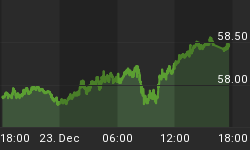In my daily trip around the latest opinions and analyses of the precious metals markets, there was one phrase that seems to recur again and again. That phrase is "gold is undervalued". One article I read pronounced on this matter by stating that the gold market was under government control and that the fundamentals of gold supply and demand did not matter at all. Anyone who invests in gold believing this can only be doing it in hope rather than analysis.
Another article made the novel suggestion that gold is undervalued because gold mining companies diluted shares and took on more debt in order to mine more gold (the implication being that without this debt, less gold would have been mined, therefore the price would be higher).
Apart from some questionable analysis (using number of shares instead of the self-adjusting share price and expressing ratios by ounce of gold rather than the price of gold), the conclusion was again that gold was undervalued.
But is that true? Is there some indefinable price which gold "should" be at but somehow is being held back? Can the advocates of this theory tell us what this mysterious price of gold is? Is it $5000 or $10000 or perhaps higher? And why is it always "undervalued"? Was there ever a time in the last 15 years when it was "overvalued"?
Or is the market sufficiently free and efficient to accurately discover the price of gold better than any other mechanism that science and society can offer? I think it is as it seeks equilibrium between buyers and sellers across all markets at all times across the world. That, of course, will include any so called surreptitious sellers and buyers beloved of conspiracy theorists. As you can guess, I do not subscribe to the theory that paper gold can hold down the price of physical gold for any sustained period (but that's another article for another day).
But, going along with this view, how would you devise a metric as to whether gold is overvalued or undervalued? Perhaps, like the famous price earnings ratio of the equities market, we can see whether gold is above or below an average historic metric? One approach would be to calculate the inflation adjusted price of gold over the last 140 years and then work out the average price over that same period. The result is the chart below.
The average price of gold turns out to be about $562 per ounce. As you can see, gold is well above that value just now. By way of comparison, the P/E ratio of the US equity markets is somewhere around 24 and the historic average is nearer 16. This is used as an indication that stocks are overvalued and should be sold. Does this mean the chart above is issuing a sell signal for gold?
That is rather debatable, just as the stock market can gravitate for years above its P/E average, so could gold. The point I am demonstrating is that I have found a metric that suggests gold is overvalued, but will certain analysts agree with this? I don't think so and I would have my own reservations (as regards silver, this is for subscribers only).
My take on this pricing perception is that it doesn't matter, the price of gold is neither undervalued nor overvalued, and it is as close to the correct price as it can be. What is actually up for debate is whether events will change in the future that make the current price of gold undervalued or overvalued by comparison.
In other words, events change and the gold prices adjusts accordingly as the market absorbs the information. For example, if information arrives which suggests the supply of gold may become constrained in the imminent future, then the price should rise.
However, that does not mean that gold was previously underpriced. It merely means new information means a new price adjustment. In regards to the information published by gold conspiracy theorists, the market has absorbed and assessed that information long ago, made its collective decision and reflected that in the price.
Of course, if verifiable information came to the market that Fort Knox was empty; the price would readjust to the upside. But it cannot be said that gold prior to that point was undervalued as the market had as best as possible reflected all knowledge available.
In this light, going back to the argument that gold mining companies have rendered gold undervalued due to share dilution and debt loading, this is again a non-argument. The truth is the gold price has adjusted to a changed paradigm in the way it is extracted from the ground. What is actually being said is that gold is undervalued compared to a paradigm where mining companies do not dilute shares or increase debt.
But that is merely a theoretical construct in the same way as one could state that gold is undervalued (or perhaps overvalued?) because governments impose royalty taxes on indigenous gold mine production. Markets deal in reality not theory. It is the cumulative effect of myriads of buyers and sellers striking a deal for their particular piece of gold.
Does this mean I am not bullish on gold? Certainly not. The point is analysts should try and avoid language which may give investors a false impression of the current situation (with the emphasis on "current"). In my opinion, the price of gold will rise as inflation returns and when Peak Gold arrives. When these events become verifiable facts, then the market will adjust and that will be somewhere well north of where we are just now.
Further analysis of silver can be had by going to our silver blog at http://silveranalyst.blogspot.com where readers can obtain subscription details for the Silver Analyst newsletter. Comments and questions are also invited via email to silveranalysis@yahoo.co.uk.
















